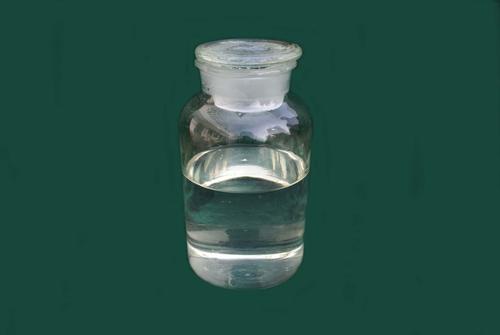[Alias] Nitrogen water, nitrogen water, hydrogen nitrogen water.
[Molecular Formula]HNO3

[Property span>]五oxygen-containing acid of valence nitrogen. Pure nitric acid is a colorlesscolorlesstransparent fuming liquid with a special odor. MeltPoint-42℃,boiling point83℃(anhydrous), Density1.5027g/cm3(25℃) . 68.4%NitrogenAcid is a constant boiling mixture with the highest boiling point(121.9℃). at–41℃ (freezing point), is white snow-like crystal . Nitric acid and water can dissolve each other freely, Alsosoluble in acetateether, releases heat when dissolved. The content of commercially available dilute nitric acid is49%,it is slightlyyellow. Nitric acid can conduct electricity and is a strong monovalent acid. It is very unstable and will decompose and release oxygen when exposed to heat or light for a certain period of time. The more concentrated nitric acid, the easier it is to decompose. When concentrated nitric acid decomposes, it produces dioxidenitrogen(NO2),in the nitric acid molecule+ 5 priceNitrogenis reduced to+4Valence; when dilute nitric acid decomposes,Generate nitric oxide(NO), in the nitric acid molecule+ 5Valence nitrogenis reduced to +2price. Visible concentrated nitric acidBoth dilute nitric acid and dilute nitric acid are oxidizing, but concentrated nitric acid is a strongoxidizingAgent, canpassivatealuminum, remove gold,Platinum, Rhodium, Tantalum、With the exception of iridium, it can oxidize almost all metals.Reaction with ethanol will causeexplosion,Mixing with sawdust, organic matter, etc. can cause combustion. Concentrated nitric acid is extremely corrosive. Splashing on the skin can cause burns and stain yellow spots. It can also damage mucous membranes and respiratory tract.
[Use]Nitric acid is an important chemical raw material with a wide range of uses. It is widely used in fertilizers, fine chemicals, printing and dyeing, chemical fibers, pharmaceuticals, etc. Metallurgy, photographic materials and other industries, such as used in the manufacture of ammonium nitrate, nitrate phosphate fertilizer, calcium ammonium nitrate, potassium nitrate, calcium nitrate, silver nitrate and other chemical fertilizers and nitrate products. Used in organic synthesis to produce nitro compounds such as nitromethane, nitroethane, and dinitrobenzoic acid. In the printing and dyeing industry, it is used to synthesize intermediates such as p-nitroanisole and p-nitrophenol, and is also used as a corrosive agent for printing rollers. In the pharmaceutical industry, it is used in the synthesis of intermediates such as p-nitroacetophenone, m-nitroaniline, and p-nitrobenzaldehyde. The coating industry is used to make various nitro varnishes and nitro enamels; the rubber industry is used to make intermediates for accelerator M; the national defense industry is used to produce explosives such as trinitrotoluene, nitroglycerin, picric acid, nitrocellulose and other metallurgical industries Used to purify rare earth metals and separate precious metals, and used in the catalyst industry to produce reactive alumina. 14 Nitric acid can also be used as a strong oxidant to oxidize aniline, alcohol and other chemicals. It can oxidize carbon into sulfur dioxide and sulfur into sulfur dioxide. Take advantage of its special effect on organic matter. Commonly used to identify protein-containing substances (such as wool, feathers, etc.)
[Brief preparation method]
①In industry, nitric acid is often produced by ammonia oxidation. Ammonia can be catalytically oxidized with air (or oxygen) into nitrogen dioxide, which can be dissolved in water to obtain about 60% nitric acid.
②90%-100% concentrated nitric acid can be obtained by dehydrating dilute nitric acid, or by reacting sulfuric acid and sodium nitrate (saltpeter).
③ To prepare a small amount of nitric acid in the laboratory, concentrated sulfuric acid and sodium nitrate can be mixed and heated in a retort. The generated nitric acid vapor will be condensed to produce nitric acid.
[Safety and Protection]Nitric acid is a first-level acidic corrosive product. Hazardous Regulation No.: 91002. It should be mixed with organic matter, oxidants, and flammable substances. Chemicals, strong alkali, calcium carbide, metal powder, etc. are stored in isolation. Avoid sunlight exposure. Concentrated nitric acid should be transported in aluminum tankers, and dilute nitric acid should be transported or stored in stainless steel or fiberglass reinforced plastic tankers or storage tanks. A small amount of concentrated nitric acid can be packed in acid-resistant ceramic cylinders, and dilute nitric acid can be packed in polyethylene plastic barrels (10L, 20L). The packaging should be labeled with a “Corrosive Materials” sign; in the event of a fire, yellow sand, carbon dioxide fire extinguishers and mist water can be used to put out the fire. Be careful to prevent acid from splashing when putting out the fire.
Human bodySkinContact with nitric acid can cause severe burns. It is especially dangerous if it splashes into people’s eyes. Steam can sting the lungsirritationVery large. SkinWhen touched, Rinse immediately with plenty of water,or use span>2%About 2% baking sodaSolutionAfter washingthen bandage,Ointment can be applied if necessary.

 微信扫一扫打赏
微信扫一扫打赏

